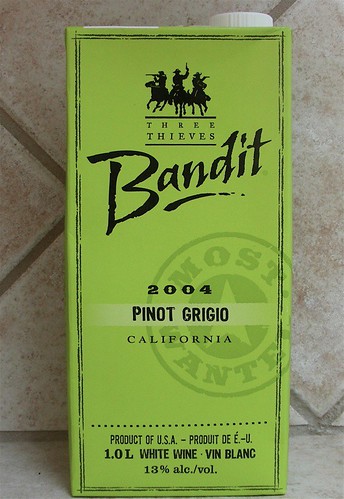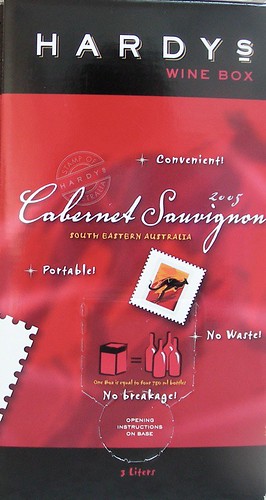 The first wine I tried was the 2004 Three Thieves Bandit Pinot Grigio sold in a one-liter Tetra-pack for $7. “We stole money from the bottle and gave it to the wine” claims the producer Three Thieves on the box. According to the winemaking notes, the wine is a California blend of 80% Pinot Grigio, 12% Sauvignon Blanc, 4% Chenin Blanc, 4% Muscat. It was cold-fermented at 50F in stainless steel to retain the fresh, fruity aromas of fermentation and was not permitted to undergo a secondary malolactic fermentation to ensure crisp acidity.
The first wine I tried was the 2004 Three Thieves Bandit Pinot Grigio sold in a one-liter Tetra-pack for $7. “We stole money from the bottle and gave it to the wine” claims the producer Three Thieves on the box. According to the winemaking notes, the wine is a California blend of 80% Pinot Grigio, 12% Sauvignon Blanc, 4% Chenin Blanc, 4% Muscat. It was cold-fermented at 50F in stainless steel to retain the fresh, fruity aromas of fermentation and was not permitted to undergo a secondary malolactic fermentation to ensure crisp acidity. The big surprise was that the wine was actually very pleasant. It had a very pale yellow color and a subtle nose of honeyed pear. On the palate, it was dry and crisp with a creamy mouthfeel and an aftertaste of apple. Transfer the wine into a regular glass bottle and serve it to your friends on a warm summer day: they will love it!
 I also tried a red wine from South Eastern Australia, the 2005 Hardy's Stamp of Australia Cabernet Sauvignon, sold in 3-liter box for $16. In Australia, this kind of wine is pretty common as more than 50 percent of all wine consumed in the country is from boxes.
I also tried a red wine from South Eastern Australia, the 2005 Hardy's Stamp of Australia Cabernet Sauvignon, sold in 3-liter box for $16. In Australia, this kind of wine is pretty common as more than 50 percent of all wine consumed in the country is from boxes.The bag-in-the-box system was actually created 40 years ago by the Scholle Corp. There is a vacuum-sealed plastic bag inside the cardboard box that keeps the wine in a sterile environment. As wine is poured from the tap, the bag collapses, blocking air from reaching the wine and preventing oxidation. However, the wine should be consumed within a month after opening.
So I poured the wine from the tab. It had a dark red/purple color, a heady nose of sweet black berries, a soft and full texture and a finish of ripe fruit and licorice. Although not the most exciting wine, it is a solid everyday drinking wine. But 3 liters is a lot; I may use some of it in the coming days in a beef stew.
Technorati tags:: wine food & drinkwine blogging wednesday wbw wbw31
1 comment:
I agree that some wines are not great in the Box- (in France we call them BIB's- Bag in Box!) They usually don't travel well either- often the disappointment of travellers taking some home. However, the wine I wrote about, does drink well in the box and does travel.... try some soon....
Picpoul- the little known wine with a great future
This rare little gem of a white wine can be found in the Languedoc, France. Its full name is Picpoul de Pinet. Situated on a limestone plateau, the vineyards of Picpoul overlook the oyster and mussel-farming centre of the Thau lagoon. The white wine is made from a single Piquepoul grape variety and is a light acidic wine, with floral and citrus fruit aromas, which render it an ideal accompaniment to seafood. The AOC Coteaux du Languedoc: Picpoul de Pinet classification applies only to white wines.
Picpoul is a rare, ancient French grape that thrives in the coastal sands near Sète in the Languedoc, by the Mediterranean Sea. Its blend of refreshing acidity and aromatic fruit flavors of citrus and peach, make it a fantastic, full-bodied wine to enjoy with food. It is particularly well suited to seafood because it has more floral flavors than a mineral wine, like a Sancerre. Unlike Voignier, another rare French white grape, Picpoul has not yet been exported much and is consumed almost exclusively by the locals and tourists who vacation in the area.
This clear, light-gold wine breathes appetizing aromas of peaches, juicy and fresh, with a back note of lemon-lime. Crisp and tart, white-fruit flavors and lemon-squirt acidity are fresh and cleansing in a very long finish. Not overly complex but bright and appealing, it's a first-rate seafood wine. It has been called the Muscadet of the south of France. It is the wine that is usually served with oysters that can be found along the coasts of the Languedoc.
Serve very cool between 6 and 8°C to accompany all seafood, shellfish and fish. It can also be served as an aperitif, either alone or with a touch of crème de cassis (blackcurrant) or crème de mûre (blackberry).
Picpoul Blanc (also spelled Piquepoul Blanc) is one of the lesser-known Rhône varietals. It is one of the thirteen permitted varietals in Châteauneuf-du-Pape, where it is used primarily as a blending component to take advantage of its acidity. Like the better known Grenache and Pinot, Picpoul has red, white and pink variants, though Picpoul Noir and Picpoul Gris are very rare. Literally translating to “lip stinger”, Picpoul Blanc produces wines known in France for their bright acidity, minerality, and clean lemony flavor.
Most scholars believe Picpoul is native to the Languedoc region of Southern France, where it is still found today. Records from the early 17th century indicate that it was blended with Clairette (another white Rhône varietal) to form the popular sweet Picardan wine (not to be confused with the Chateauneuf du Pape varietal of the same name), which was exported by Dutch wine traders from Languedoc throughout Northern Europe in the 17th and 18th centuries. After the phylloxera invasion at the end of the 19th century, Picpoul was not widely replanted. Today it is best known from Picpoul de Pine, the crisp light green wine of the Pinet Region in the Côteaux de Languedoc.
So, when you are next in the Languedoc, or looking for wines in your Wine merchant’s store, take a serious look at wines from Picpoul. You will not be disappointed!
Further info on http://www.wine-food-languedoc.com
Post a Comment